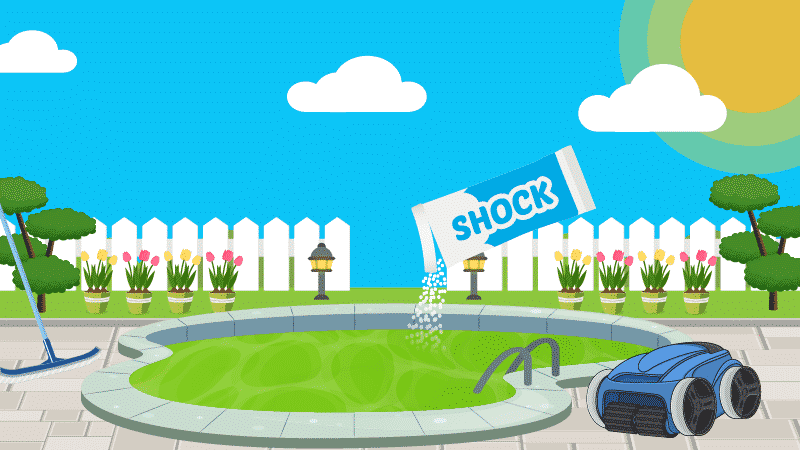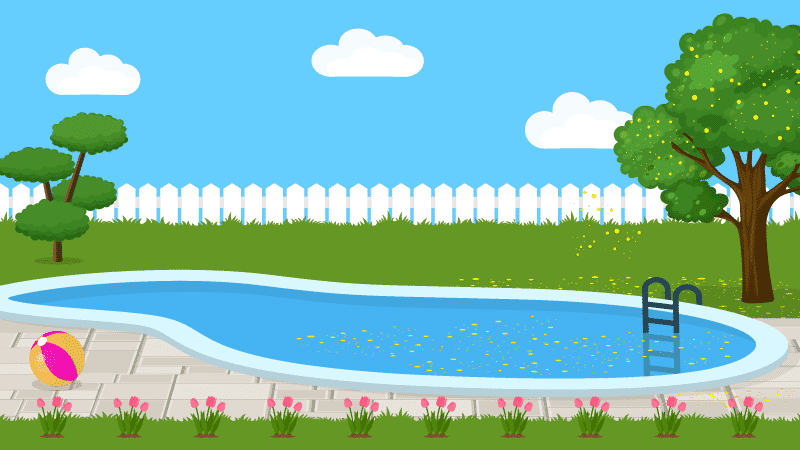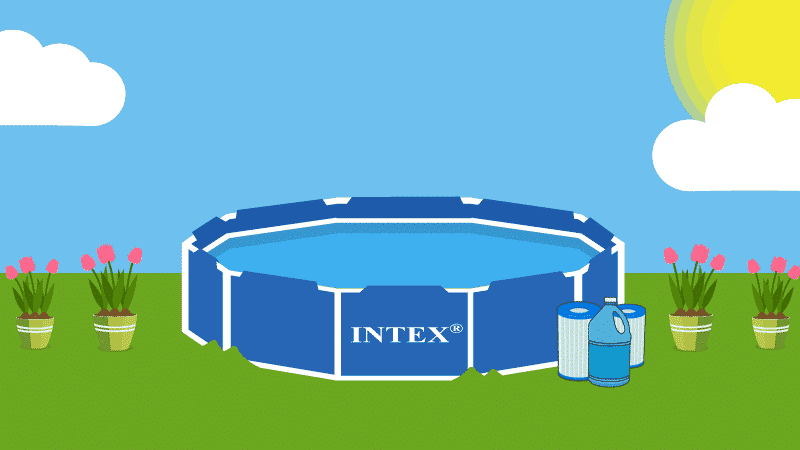How to Drain an Above Ground Pool (Even Without a Pump)
Need to drain your above ground pool? Maybe it’s full of nasty, stagnant water. Or maybe you need to completely take it down for the season or make emergency repairs. Either way, you’ll need to drain some or all of the water from your swimming pool. And if you’ve never drained your pool before, doing it the wrong way can damage your pool liner, or worse: the whole thing can collapse.
Here’s a step-by-step guide on how to drain an above ground pool with or without a pump. You can watch the video tutorial below. Or keep reading for the complete pool draining guide.
Stop wasting time and money with confusing water chemistry and maintenance. Our effortless system guarantees to keep your pool balanced, sanitized, and crystal clear all year. Works for all pools including saltwater.
When Should You Drain an Above Ground Pool?
There are only a few reasons you’ll ever need to completely drain your pool. Depending on the size of your swimming pool, you should only need to ever partially drain it, even to fix leaks. But there are several situations when you’ll want to drain out most or all of your water:
1. Your water chemistry is beyond rebalancing
Part of regular pool care is maintaining your pool’s water chemistry. But even if you’re meticulous about your pool maintenance, you can end up with a build-up of total dissolved solids (TDS). These are the by-products of all the chemicals you use to keep your pool clean that slowly build up over time. When your TDS level is greater than 2,500 parts per million (PPM), you’ll need to drain and replace some of your pool water with fresh water.
Another reason to replace your pool water? Your Cyanuric Acid (CYA) levels are too high. The only way to bring those levels down is by partially draining your pool and replacing it with fresh water.
2. You need to make structural repairs
You can handle most pool repairs without draining all of the water from your above ground pool. It’s even possible to patch and repair your pool liner while it’s still underwater. Special maintenance, however, may require an empty pool. And that includes jobs like completely replacing your pool liner or repairing your pool frame’s base.
3. You need to store your pool for the winter
If you have a smaller above ground swimming pool and live in a cold climate, you may need to drain and store it during the winter. Not only will this protect your pool from freezing temperatures, but storing your pool in the off-season may be required to preserve your warranty.
How to Prepare an Above Ground Pool for Draining
Before you drain your above ground pool, you’ll need to have a few things prepared:
- Have a water disposal plan. Check with your city for rules or regulations about how to dispose of pool water, especially if you’re draining your entire pool. Most areas won’t allow you to empty your pool water into storm drains, so you’ll need to empty it directly into the sanitary sewer line outside your home.
- Bring down your pool’s chemical levels. No matter where you’ll dispose of the water, you need to be sure your pool water isn’t full of chemicals before you do. Stop adding chemicals in the days before you drain and test your water before you empty your pool to make sure it’s chlorine neutral. Then check with your local water authority for other chemical requirements. If you need to speed up the process, consider using a chlorine neutralizer.
- Wait for mild, warm weather. Depending on where you live, you may be limited in terms of when you can drain your pool. Check with the local water authority for any rules. But otherwise, plan on waiting for a clear day that’s not too hot. Aim for temperatures at or below 85°F (29°C) to prevent damage to your pool liner.
- Turn off pumps, filters, heaters and automatic timers. If you have any pool equipment with automatic timers, like pumps, turn them off before you start draining. If the water level falls below the skimmer line and the pump turns on, it can overheat.
- Plan to stay near your pool when it drains.
Never leave your pool unattended while it’s draining or refilling. You can expect it to take 8 to 14 hours to drain, based on the size of your pool and whether you’re using a pump or a hose. And keep in mind that you’ll also spend about the same amount of time filling it up again (check out our pool fill time calculator to help you determine how much time it’ll take to drain or fill your pool).
3 Ways to Drain an Above Ground Pool
You have three options for how to drain an above ground pool: siphoning water with a garden hose, using a submersible pump, or using your pool’s drain adapter.
If you only need to partially drain your pool because you need to adjust your water chemistry, siphoning the water out with a garden hose is an easy option. However, if you need to completely drain a larger pool, you’ll want to use a sump pump to speed up the process.
Finally, if you’re draining a pool to store it during the winter months in a colder climate, you may want to use your pool’s built-in drain adapter (if there is one).
Here’s a step-by-step walk-through of each method.
How to Drain an Above Ground Pool Without A Pump: Garden Hose Siphon Method
If you’re only partially draining your pool or you don’t want to use a pump, you can use a garden hose to siphon out your pool water. It will take longer than using a pump, but this easy, DIY method means you won’t need to buy or rent any equipment.
The easiest way to create a siphon is by submerging the entire garden hose underwater and then removing one end of the hose out of the pool:
- Submerge the entire hose underwater in the pool. Hold both ends below the surface until the air bubbles stop. This means the hose is now full of water.
- Place your hand over one end of the hose. While keeping that end covered, pull that end of the hose out of the water.
- Place the end you’re holding on the ground at a lower level than the pool’s waterline. When you move your hand away, the water should start siphoning out. The hose on the outside of the pool needs to be lower than the water level in the pool. And make sure the end that’s in the water remains under the surface.
If your water level is too shallow for this method or you’re not getting a siphon, you can speed up the process by attaching your garden hose to your house’s spigot (or outdoor faucet).
How to Make a Garden Hose Siphon with a Spigot
- Connect one end of your garden hose to your spigot and place the other end in your pool. This setup is the same as if you were going to fill up your pool with water. Make sure the end of the garden hose that’s in the pool is secured or weighed down so it won’t pop out.
- Turn on the water. Water should be running through your hose and filling your pool.
- Once the hose is completely full of water, unscrew it from the spigot. Place that end of the hose on the ground and then turn off your spigot. This should create a siphon at this point and water should be draining from your pool out the hose. Just make sure this end of the hose is lower the water level in your pool.
Keep in mind that your hose siphon will get slower and slower as the water level decreases. If you have a larger above ground pool, it can take several days to complete the draining process. It’ll also leave an inch or two of water at the bottom of your pool liner. Any remaining water can be removed by a shop vac.
How to Drain an Above Ground Pool With a Sump Pump
Using a submersible electric pump, a.k.a. a sump pump, to drain your pool is much quicker than using a garden hose. And if you need to drain your pool every winter, buying a sump pump can be a worthwhile investment. But you can also rent one from a local hardware store if it’s a one-time job and you want to save some money.
You’ll need:
Make sure the power cord of your sump pump is long enough to reach the bottom of the pool from the nearest outlet. While it is possible to use an extension cord, it needs to be heavy-duty enough to handle a sump pump.
- Attach the garden hose to your sump pump.
- Locate your house’s clean-out port. This is usually in the ground in your front yard near a water spigot. Open the clean-out port by unscrewing the cap. Unravel your garden hose and place it inside the port. Just keep in mind that your hose won’t be sanitary afterward.
- Place the sump pump underwater in the middle of your pool floor. Turn on the sump pump by plugging it in. Remember, try not to use an extension cord. At this point, water should be flowing through the hose.
- Monitor your water flow. Carefully watch the pump, hose, and power cords to make sure everything is running smoothly and that the water is properly draining into the clean-out port. Remember, never leave a sump pump running unmonitored.
- Turn off your pump once the water level is too low. Once the water level is low enough that the pump isn’t pushing water out, turn it off and take it out of the pool. It’s okay if you still have a few inches of water at the bottom. If you need to remove all of the water, use a shop vac.
Do not use your pool pump to drain water from your pool. If your water level dips below your skimmer, your pump will begin to pull in air. And since there’s no water flowing through it, it can burn out or become permanently damaged.
How to Drain an Above Ground Pool With a Drain Adapter
If you have an Intex, Coleman, or other temporary above ground pool, your pool may have a drain adapter. This allows you to drain the pool faster if you have to take it down at the end of the season.
- Connect the drain plug to a garden hose before opening the value. Without a hose, the water will drain around and underneath the pool, softening the ground your pool sits on. You may need an adapter to connect your garden hose to your pool.
- Place the other end of the garden hose away from the pool. Be sure it’s not draining into a neighbor’s yard.
- Monitor the flow of water. Depending on how many gallons of water your pool holds, you may need to move your hose occasionally. Remember, your water shouldn’t be flowing into a storm drain.
How to Refill Your Above Ground Pool
If you’re making repairs or adding fresh water, don’t plan on leaving your pool empty or dry for too long. Sunlight and weather can damage the liner of an empty pool. So as soon as you’ve completed your repairs, start refilling your pool. Consider using multiple garden hoses to speed up the process.
Once the water reaches halfway up your skimmer, you can turn on your pool pump and filter again. Then retest and rebalance your water. If you need help figuring out the right chemistry levels for your pool, check out our guide on Basic Pool Chemistry 101.
Frequently Asked Questions About How to Drain an Above Ground Pool
Looking for more help with draining your pool? Find answers to the most common questions here.
How long does it take to drain an above ground pool?
It can take anywhere from 8 to 14 hours to drain your pool, depending on how large it is and whether you use a garden hose or a sump pump. Do not leave a sump pump unattended as you drain.
What’s the fastest way to drain an above ground pool?
Using a submersible pump is the fastest way to drain your pool. It acts like a vacuum to remove water quickly, but you’ll need to monitor it while it’s running. A garden hose siphon is another option for draining out water, but it will take much longer.
How often do I need to drain an above ground pool?
It is rare that you will ever have to completely drain an above-ground pool, unless you take it down every year for the winter. Otherwise, most minor leaks and liner repairs can be done while there is still water in the pool. However, if your cyanuric acid or Total Dissolved Solid levels are too high, you’ll need to partially drain and replace your water.
How do I drain my above ground pool without a pump?
You can drain your above ground swimming pool using a regular garden hose and creating a siphon. It will just take much longer than using a sump pump and the siphon will start to slow down as your pool’s water level gets low.
Can I drain my pool with my pool pump?
Never use your pool pump to drain an above ground pool. You’ll pull air into the suction line, which can damage or burn up your pump. Always use a submersible pump to drain an above ground swimming pool.
4 Ways We Can Help With Your Pool
- Pool Care Cheat Sheets (Free): Easy-to-use downloadable guides to help you keep track of taking care of your pool this year.
- The Pool Care Handbook: An illustrated guide to DIY pool care, including water chemistry, maintenance, troubleshooting, and more.
- The Pool Care Video Course: You’ll get 30+ step-by-step videos and a downloadable guide with everything you need to know about pool maintenance.
- The Pool Care App: Enter your water test results. Get a custom treatment plan. Know exactly what chemicals to add to keep your pool clear.









